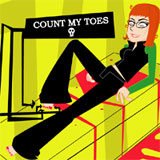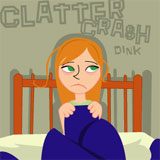|
TOONS FOR A NEW MEDIUM By Tim O'Neil and Dan Goodin
John Allison's comic strip, Scary go Round, is populated with a gamut of characters ranging from an evil geneticist who crosses humans with monkeys to a psychotic boy who takes the form of a poisonous gas so he can sneak into the girls locker room.
 If it doesn't sound like the typical fare found on the funny pages, there's a reason: the only place you can read this five-day-a-week series is online. If it doesn't sound like the typical fare found on the funny pages, there's a reason: the only place you can read this five-day-a-week series is online.
"Internet comics have helped inject new diversity of content into what was a shrinking field," says the 27 year-old Allison, who makes his home in Manchester, England. "A lot of small publishers have disappeared since I started reading comics in the mid-80s."
Scary go Round, just one of hundreds of Web comics, is a decidedly British strip, following the tongue-in-cheek adventures of a group of 20-somethings as they mix typical suburban life with fantastic plots out of spy novels and science fiction. Think Scooby Doo meets Monty Python.
With no editors, syndicates or middlemen, a fresh breed of artists is bringing new rules to and old form and developing a grass-roots following in the process. Other Web comics include Achewood, an obtuse strip that brings the toys of its creator, Chris Onstad, to life. It follows characters through such rites-of-adulthood as binge drinking, road trips and Faustian deals with the devil.
Edgy Internet strips like these have helped reinvigorate a once-sleepy medium. In the first half of the twentieth century, comic strips were one of the more vital and exciting pieces of popular culture. Groundbreaking works included George Herriman's Depression-era series "Krazy Kat," perhaps the most critically acclaimed strip of all time, having built a fervent following among as diverse a crowd as publishing magnate William Randolph Hearst (without whom the surreal "Krazy" would never have been published), poet e.e. cummings, and Pablo Picasso.
Walt Kelly's "Pogo," which also remains near the top of most critics' lists, brought politics to the funnies long before Doonesbury by attacking Senator Joe McCarthy at the height of the 1950s "Red Scare."
 The second half of the century, however, saw the content of comics falter, favoring simple, non-controversial and easily merchandised brands such as "Garfield" and "Dilbert." What's more, the general trend towards an aging demographic of newspaper readers has ensured that the comics page remains home to strips like "Prince Valient" and "Blondie," which are published years after the death of their creators. The second half of the century, however, saw the content of comics falter, favoring simple, non-controversial and easily merchandised brands such as "Garfield" and "Dilbert." What's more, the general trend towards an aging demographic of newspaper readers has ensured that the comics page remains home to strips like "Prince Valient" and "Blondie," which are published years after the death of their creators.
Achewood, published (mostly) five times a week, is into its third year, generates enough money for Onstad to live on comfortably, he says. "I don't just sit around all day in a leather bathrobe," he says. "We reinvest as much as possible and listen to our customers very closely."
The strip receives unique visitors "well into five figures" each day, Onstad says. His wife stopped working full-time to help with the strip, and the couple expects her to start devoting her efforts full-time soon.
"Most Web cartoonists are hobbyists now, but a lot of them have aspirations of becoming professionals," says the uni-monikered Alex, creator of Elftor, a cartoon so laced with expletives that it could make viewers of the racy TV cartoon "South Park" blush. It follows the escapades of its trash-talking title character and his drinking buddy, a wedge of Swiss cheese named Cheesetor. The surreal strip would be a perfect fit with the Cartoon Network's "Adult Swim" comedy block, which has become a staple of late night cable with bizarre programming that includes a sitcom spoof featuring the misadventures of talking, sentient fast food products.
As indulgent as it is, Elftor can still find a following, garnering 2,000 to 3,000 visitors a day and has generated about $1,500 worth of merchandising, Alex says. That's enough to pay for expenses.
There are two models for making money with comic strips on the Internet. One relies on subscription services, such as Modern Tales (www.moderntales.com) and its subsidiary, Serializer (www.serializer.net), which charge fees to access a wide variety of content and pass a portion of the take to artists for their contributions.
The other model sees artists such as Onstad, Allison and Alex offer their strips for free, making money off ancillary products such as books and clothing. The latter isn't much of a departure from traditional methods, its adherents say.
"In the UK, you don't pay to watch the Simpsons or South Park, and you never bought the paper just for Garfield or Peanuts," says Allison. "Yet the auxiliary merchandising was what made all of those properties money makers."
That's not to say Web cartoonists see themselves as part of the mainstream.
"I have no desire to be in the newspaper or to be part of any syndicate," Onstad says. "The last thing I want is to ask some cookie-cutter motherfucker how he can compromise my art."
And it's not to say Web comics aren't without its disadvantages.
"The biggest is that it's hard to make money or even gain a large readership," Alex says. "You have freedom to do whatever you want, but that doesn't mean anyone will read it."
|